Introduction
Medical imaging plays a crucial role in modern healthcare, allowing doctors to visualize the internal structures of the body without the need for invasive procedures. By using various imaging techniques, healthcare professionals can diagnose and monitor a wide range of medical conditions. In this article, we will explore the four main types of medical imaging and their applications in the field of healthcare.
Table of Contents
- What is medical imaging?
- X-ray imaging
- Magnetic Resonance Imaging (MRI)
- Ultrasound imaging
- Computed Tomography (CT) scan
- Key Takeaways
- FAQs
- Conclusion
What is medical imaging?
Medical imaging is a branch of medicine that uses various techniques to create visual representations of the internal structures of the body. These images help healthcare professionals diagnose and monitor conditions such as fractures, tumors, infections, and abnormalities.
X-ray imaging
X-ray imaging is perhaps the most well-known and widely used type of medical imaging. It uses a small amount of ionizing radiation to create images of the body’s internal structures. X-rays are commonly used to visualize bones and detect fractures, tumors, and infections. This imaging modality is quick, non-invasive, and relatively inexpensive.
Magnetic Resonance Imaging (MRI)
Magnetic Resonance Imaging, or MRI, uses a powerful magnetic field and radio waves to generate detailed images of the body. Unlike X-rays, MRI does not use ionizing radiation. Instead, it relies on the body’s natural properties to create images. MRI is particularly useful for imaging soft tissues, such as the brain, muscles, and organs. It can help diagnose conditions like tumors, strokes, and spinal cord injuries.
Ultrasound imaging
Ultrasound imaging, also known as sonography, uses high-frequency sound waves to create images of the body’s internal structures. It is commonly used to visualize the developing fetus during pregnancy, but it can also be used to examine other organs, such as the liver, kidneys, and heart. Ultrasound imaging is safe, non-invasive, and does not involve ionizing radiation.
Computed Tomography (CT) scan
A Computed Tomography scan, or CT scan, combines X-rays and computer technology to create cross-sectional images of the body. CT scans provide detailed images of bones, organs, and blood vessels. They are useful in diagnosing conditions such as tumors, infections, and internal bleeding. CT scans involve a higher dose of radiation compared to X-rays, but the benefits often outweigh the risks.
Key Takeaways
- Medical imaging allows healthcare professionals to visualize the internal structures of the body without invasive procedures.
- The four main types of medical imaging are X-ray imaging, Magnetic Resonance Imaging (MRI), ultrasound imaging, and Computed Tomography (CT) scan.
- X-ray imaging is commonly used to visualize bones, while MRI is useful for imaging soft tissues.
- Ultrasound imaging is safe and commonly used during pregnancy to visualize the developing fetus.
- CT scans combine X-rays and computer technology to create detailed images of the body.
FAQs
What are the risks of medical imaging?
While medical imaging techniques are generally safe, some imaging modalities involve exposure to ionizing radiation, which carries a small risk of developing cancer. However, the benefits of accurate diagnosis and treatment often outweigh the risks associated with imaging procedures.
How long does a medical imaging procedure take?
The duration of a medical imaging procedure depends on the specific modality and the area being imaged. X-rays and ultrasound imaging are usually quick, while MRI and CT scans may take longer, typically ranging from 30 minutes to an hour.
Conclusion
Medical imaging plays a vital role in diagnosing and treating various medical conditions. Understanding the different types of medical imaging techniques, such as X-ray imaging, MRI, ultrasound imaging, and CT scans, can help patients and healthcare professionals make informed decisions about their healthcare. By utilizing these imaging modalities, doctors can visualize the internal structures of the body and provide accurate and timely diagnoses, leading to improved patient outcomes.


